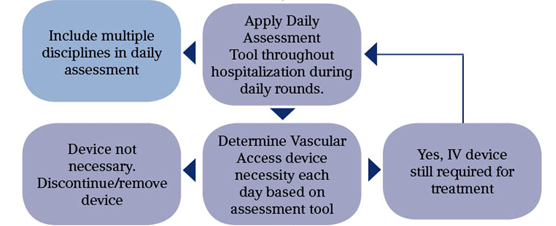| First Section Page | Page 8 of 9 | Last Section Page |
Daily Review of Line Necessity with Prompt Removal of Unnecessary Lines

Once the central venous access device (CVAD) has been indicated and placed, daily assessment begins. The patient is assessed daily to evaluate the health of the vessels, the functionality of the device and the continued need for the device. The IHI and CDC recommend prompt removal of lines as soon as they become unnecessary
(,).
During daily assessment of the patient, consider:
- Is the catheter still necessary for treatment of this patient or just convenient? (Don't retain catheter solely for convenience in access, such as for periodic blood draws.)
- Can the patient be switched to a peripheral IV or to oral medications?
- Are there any catheter-related complications?
- Are there alternative therapies that could be used that would allow for the removal of the line?
- Is therapy being discontinued?
- Is the patient satisfied and comfortable with the current delivery of medications?
The goal of vascular access device use is to find the best way to administer the therapies required to help the patient recover while doing the least amount of damage to the patient's vascular system. As soon as it is determined that the vascular access device is no longer medically necessary, it should be removed from the patient.
Remember, a bundle is a set of evidence-based practices that individually improve care, but when applied together, they result in substantially greater improvement of care. The Central Line Bundle has proven to provide better outcomes for patients requiring vascular access. The bundle is based on recommendation from The CDC and the IHI and is required by the National Patient Safety Network (,).